L2O burst onto the dining scene in May 2008 and was nominated for a James Beard award for best new restaurant in 2009. Though L2O lost to Momofuku Ko, that in no way diminishes the impressive work Chef Gras has done in such a short time. The brainchild of Chef Laurent Gras, L2O blends Chef Gras' French training under Michelin starred luminaries like Alain Ducasse, Guy Savoy, with influences he picked up during a stint in Japan. The restaurant offers 4-course, 6-course and 12-course courses in the main dining room. The restaurant has a contemporary interior dressed in warm ebony wood with white leather chairs and clean stark lines that suits the menu perfectly. The restaurant seems a bit out of place compared with the stuffy old world trappings of the hotel lobby.
In addition to the above menus, the restaurant also offers a "secret" 14 course (19 by my count) Kaiseki served in a private tatami room by a pair of kimono clad servers. The Kaiseki menu struck me as the mirror image of the main dining room, traditional instead of contemporary with a French-inspired Japanese menu rather than a Japanese-inspired French menu.


L2O Gimlet - Plymouth, House Lime Cordial, Aperol
The light citrus notes of the lime cordial are immediately apparent, though the bitter orange of the Aperol makes itself known in short order, the cocktail effectively uses liqueur to add some complexity and weight to the mix.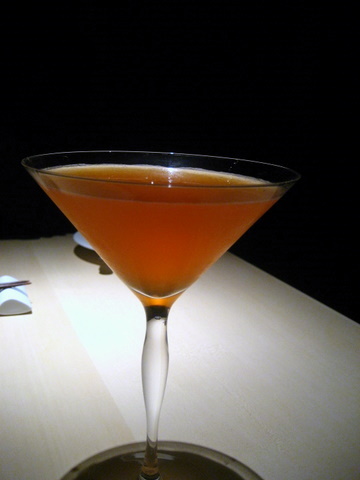
The Norman - Le Compte Calvados, Lang Beerenauslese
Sort of the opposite of the above drink, the woody smoky Calvados apple brandy was immediately apparent though on subsequent tastings, I noticed the tempering influence of the Beerenauslese's honeyed character.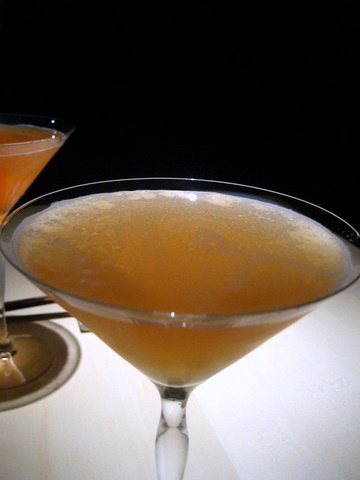
Amuse 01: Oyster, Sake, Red Wine Vinegar
The flavor of sake overwhelms the palate on the attack but that is quickly replaced by the dry brine from the oyster. I suspect the sake marinade muted the natural sweetness of the shellfish, leaving only the lingering flavor of the ocean.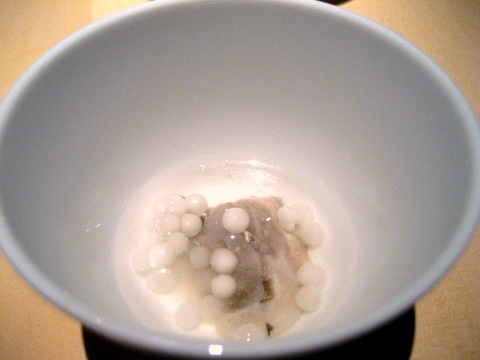
Amuse 02: Tuna, Foie Gras
A prime example of top quality tuna, presenting a clean fresh flavor and tender texture. The foie gras had a texture akin to ice cream, almost melting in the mouth, though I would have liked the liver's unctuous flavor to be more apparent in the dish.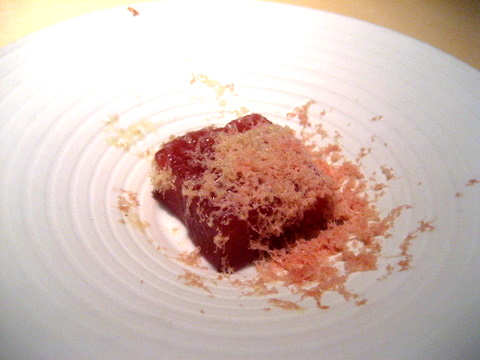
Amuse 03: Smoked Salmon, Earl Grey
Very tender smoked salmon definitely the focus of this bite, the Earl Grey dusting the edge of the fish was almost peppery in nature, a light flavor but a gritty texture that tingles the tongue. The ginger noodle was totally superfluous.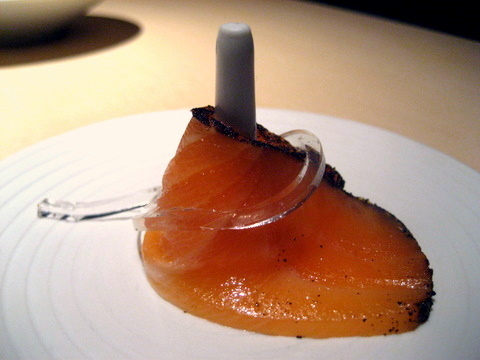
Amuse 04: Escolar Jamón, Espelette
Basically fish ham, the Escolar had a denser mouthfeel very reminiscent of pork and a salty savory flavor to match. The green sprout resting atop the fish added some moisture and a contrasting vegetal note.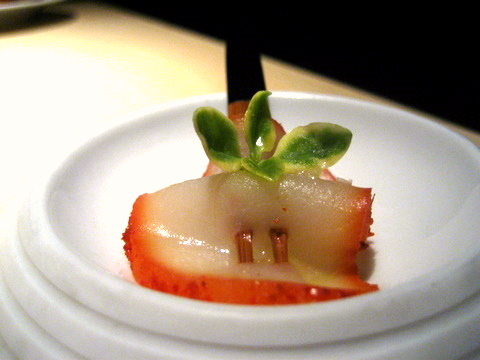
Amuse 05: Kinmedai
Szegeti, Gruner Veltliner, Sekt, Austria NV
The last of the five amuses was a bit of Kinmedai served with shiso flower and ginger oil. The shiso gives a sweet mintiness to compliment the oiliness of the fish. When taken with the ginger oil the fish had a rich sense of umami to it. The wine was a sparkling GV from a producer known for making sparklers out of non-traditional grapes, indeed the mineral driven Sekt worked nicely with all the lightly flavored fishes.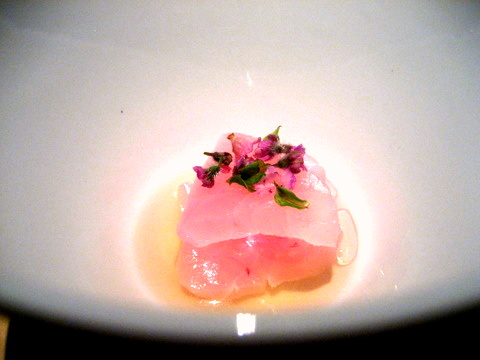
Bread - Whole Wheat, Demi-Baguette, Panalé, Rosemary Croissant, Red Onion Epi, Country Bread
A very nice bread selection overall, my favorite was the Rosemary Croissant with its buttery sweet flavor kissed with a hint of rosemary and its flaky exterior wrapped around a light airy center. My companion thought ordering all the bread at once seemed a bit piggish, but that didn't stop him from sampling from my plate
01: Medai, Salmon Roe, Shiso Flower
The medai had a firm texture and mild flavor, relying mainly on the firm ikura and shiso flower for flavor; once again the ginger noodles seem more for decoration than anything else. This dish seems to need a bit more polish, the ikura and shiso flower don't work in harmony, with only one flavor apparent at any given time. When taken with the wine, the fish developed a fishy almost oyster-like character.
Bread - Asiago Cheese
We were given a reload on bread with one new entry, an Asiago Cheese bread, creamy and mild with the cheese providing a nice weighty richness.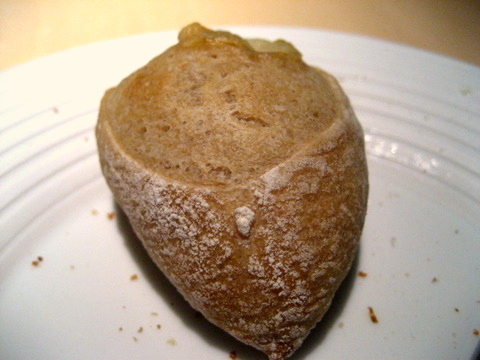
02: Sashimi, Ginger, Wsasabi
Ichishima, Silk Deluxe, Junmai, Niigata
We were given three types of Sashimi: Fluke, Kinmedai, Shima Aji each with a dollop of ponzu and soy gelée as well as a Soy Meringue. The fluke was the lightest of the three fish, a canvas for the sweet-savory notes of its accouterments. The Kinmedai was similar, really highlighting the fish in unison with the candied ginger, soy, and ponzu. The shima aji was my favorite of the three, with the yuzu kocho a wonderful accompaniment to the rich flavor of the aji. The Meringue was more like a sticky foam and tasted reminiscent of Chinese beef jerky with a grassy twist from the leafy green. I was a bit surprised how well the Silk worked with the fish. Typically I prefer a drier sake but the bolder flavors complimented the intensity of the ponzu and soy gelée paired with the fish.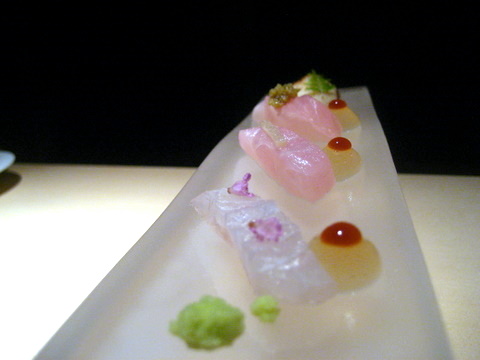
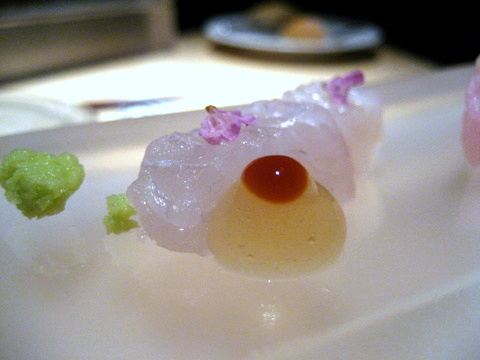
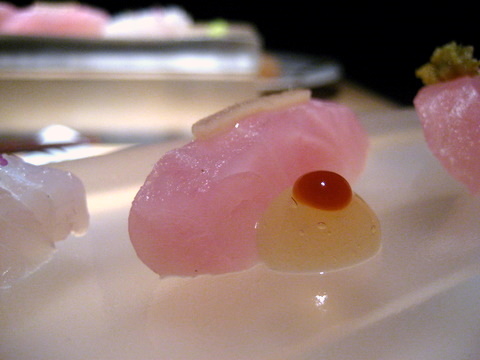
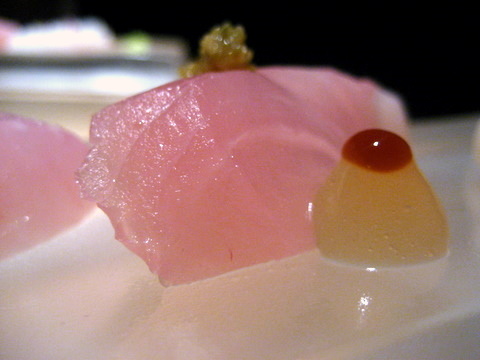
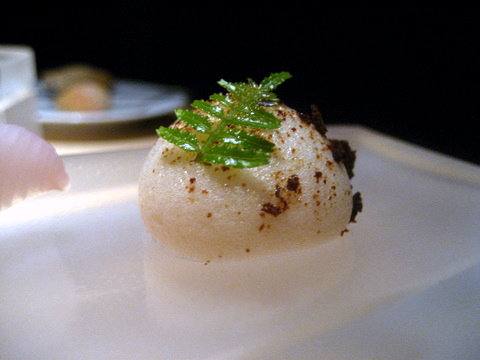
03: Nameko, Asparagus
Riesling Kabinett, Dr. H. Bergweiler, Germany, 2007
I recorded this as English Pea but the menu lists the vegetable component as Asparagus. Regardless the dish possesses a charming interplay between the earthy mushroom and the light grassy sweetness of the vegetable. I wish they did a bit more with the course but the straightforward combination is by no means unpleasant. The riesling paired with this dish emphasized the sweet side of the dish, plenty of apple and ripe fruit make for very easy drinking.
04: Tofu, Itogaki, White Soy
The house made tofu is so soft it is difficult to pick up without breaking it. The delicate tofu has a surprisingly strong flavor on its own but taken with everything else serves as a base for the white soy and ginger with a smoky finish from the Itogaki, which is a dried tuna similar to how Katsuobushi is made from dried bonito.
05: Octopus, Coconut, Togarashi, Soy Salt
Moscatel Seco, Botani, Jorge Ordoñez, Sierras de Malaga, Spain 2008
The octopus is very meaty with an almost sausage like flavor, the floral olive oil and sweetness of the coconut alleviate some of the heaviness of the dish but I was still left thinking this was a bit blunt. The wine is laden with aromas of tropical fruit and exotic flowers as well as a pronounced coconut aroma that matches well with the dish. Surprisingly for such a powerful fruit driven nose, the flavor is fairly dry.
06: Scallop, Champagne
The scallop was nicely cooked uniformly smooth and tender with a nice caramelization. The champagne brown butter filled the room with a rich sweet aroma though the flavor emphasized the tartness of the champagne. Infused with a subtle sweetness from the scallop, the soup might have been better than the scallop itself. Though the wine is listed with the next course, the Eisenthur had aromas of red apple and orchard fruit with a caramel flavor on the palate, reminiscent of a dry dessert wine.
07: Lamb Tartar, Shiro Ebi
Eisenthur, Dveri-Pax, Lyutomer-Ormoz, Slovenia, 2005
Probably my favorite course of the night, this was my first experience with raw lamb which ended up surprisingly firm with a satisfyingly chewy texture. The shiro ebi was a beautiful pairing, adding a creamy complexion and mild sweetness to the lamb. The whole amalgam was set off by the peppery herbaceous vegetables and tinged with gold powder for extra luxury.
08: Kampachi, Yuzu Butter, Tapioca
Château de'Esclans Whispering Angel, Côtes de Provence, 2006
Kampachi is a difficult fish to cook and this turned out to be one of the weaker courses of the night. The fish was a bit dry with a funky oiliness that I didn't care for though the flavor was somewhat blunted by the yuzu.
09: Lobster, Surume Ika, Foie Gras
Pinot Noir, Pökl, Bügenland, 2004
The snappy texture of the squid makes the lobster seem tender by comparison though both were quite firm and the actual differences were very subtle. Wonderful pairing of the foie to give some heft to this dish, a heavier preparation of lobster than most and a very nice departure from tradition. The wine paired with this dish emphasized more of the smoky elements making it a heavier pinot and an appropriate pairing for the shellfish.
10: Pickled Honshimeji, Salmon Roe, Grapefruit
A very nice cool palate cleanser (though not actually the last savory) with the grapefruit coming to the fore. The pickled mushrooms add a complimentary tartness but the characteristic earthiness of the mushrooms is more of an afterthought, serving to ground the vibrant acidity of this course.
11: Miyazki Wagyu Beef, Sake, Potato
Grenache, The o.g., Boeets & Scholl, Barossa Valley, Australia 2006
A fairly lean example of Waygu but still possessing abundant marbling, the tender flavorful sake marinaded beef makes for a very satisfying steak especially when paired with the grilled scallions. The accompaniments are all quite good particularly the scallion, with the interplay between the sweet onion and rich beef reminding me of an In-n-Out burger. I also really liked the potato batons though I am not sure why as they just seem like fried potatos. The wine has plenty of dark ripe fruit on the nose, with some notes of saddle on the palate, a multifaceted wine that pairs nicely with the beef.
12: Dashi
It seems a bit strange to be given a bowl of dashi soup to close such an elaborate dinner but the simple soup does a nice job as a gentle satisfying palate cleanser.
13: Chocolate, Caramel
Broadbent Madeira, Malmsey, 10 year
A very rich simple dessert, plenty of sweetness, a nice cold flavor from the caramel ice cream filling and a buttery crunch from the praline bits below. I could eat a dozen of these.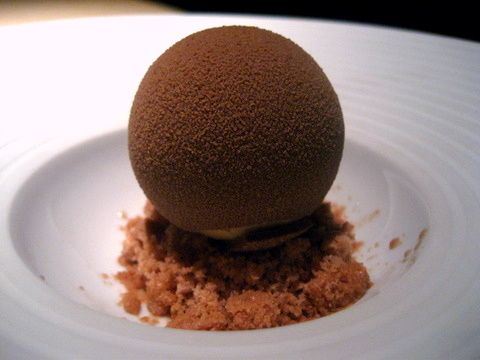
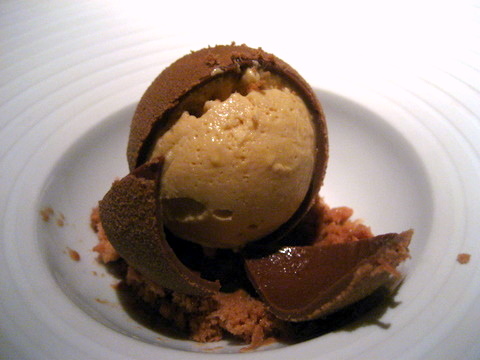
14: Mignardises - Salted Caramel Brown Butter Macaron
Simple, pure, sweet what dessert was meant to be. The macaron had a similar flavor to the previous dessert with a slightly salty twist. The cookie part of the macaron had a crisp exterior and airy sticky interior, that reminded me of Macarons a friend brought me from Ladurée.
This is not a strictly traditional Kaiseki meal by any stretch of the imagination, incorporating Western elements like bread and wine pairings. The food is very good though not outstanding, but dining in the tatami room is about the overall experience. The meal emphasizes balanced flavor pairings as well as an extraordinary dedication to presentation and service, all hallmarks of the Kaiseki tradition. If I were to return, I would like to try the main dining room though I could see myself coming back to the tatami room for a special occasion.
Saturday, May 23, 2009
L2O - 05/18/2009
Subscribe to:
Post Comments (Atom)

No comments:
Post a Comment